Zan Li
RadioDiff-3D: A 3D$\times$3D Radio Map Dataset and Generative Diffusion Based Benchmark for 6G Environment-Aware Communication
Jul 16, 2025Abstract:Radio maps (RMs) serve as a critical foundation for enabling environment-aware wireless communication, as they provide the spatial distribution of wireless channel characteristics. Despite recent progress in RM construction using data-driven approaches, most existing methods focus solely on pathloss prediction in a fixed 2D plane, neglecting key parameters such as direction of arrival (DoA), time of arrival (ToA), and vertical spatial variations. Such a limitation is primarily due to the reliance on static learning paradigms, which hinder generalization beyond the training data distribution. To address these challenges, we propose UrbanRadio3D, a large-scale, high-resolution 3D RM dataset constructed via ray tracing in realistic urban environments. UrbanRadio3D is over 37$\times$3 larger than previous datasets across a 3D space with 3 metrics as pathloss, DoA, and ToA, forming a novel 3D$\times$33D dataset with 7$\times$3 more height layers than prior state-of-the-art (SOTA) dataset. To benchmark 3D RM construction, a UNet with 3D convolutional operators is proposed. Moreover, we further introduce RadioDiff-3D, a diffusion-model-based generative framework utilizing the 3D convolutional architecture. RadioDiff-3D supports both radiation-aware scenarios with known transmitter locations and radiation-unaware settings based on sparse spatial observations. Extensive evaluations on UrbanRadio3D validate that RadioDiff-3D achieves superior performance in constructing rich, high-dimensional radio maps under diverse environmental dynamics. This work provides a foundational dataset and benchmark for future research in 3D environment-aware communication. The dataset is available at https://github.com/UNIC-Lab/UrbanRadio3D.
Temporal Spectrum Cartography in Low-Altitude Economy Networks: A Generative AI Framework with Multi-Agent Learning
May 21, 2025Abstract:This paper introduces a two-stage generative AI (GenAI) framework tailored for temporal spectrum cartography in low-altitude economy networks (LAENets). LAENets, characterized by diverse aerial devices such as UAVs, rely heavily on wireless communication technologies while facing challenges, including spectrum congestion and dynamic environmental interference. Traditional spectrum cartography methods have limitations in handling the temporal and spatial complexities inherent to these networks. Addressing these challenges, the proposed framework first employs a Reconstructive Masked Autoencoder (RecMAE) capable of accurately reconstructing spectrum maps from sparse and temporally varying sensor data using a novel dual-mask mechanism. This approach significantly enhances the precision of reconstructed radio frequency (RF) power maps. In the second stage, the Multi-agent Diffusion Policy (MADP) method integrates diffusion-based reinforcement learning to optimize the trajectories of dynamic UAV sensors. By leveraging temporal-attention encoding, this method effectively manages spatial exploration and exploitation to minimize cumulative reconstruction errors. Extensive numerical experiments validate that this integrated GenAI framework outperforms traditional interpolation methods and deep learning baselines by achieving 57.35% and 88.68% reconstruction error reduction, respectively. The proposed trajectory planner substantially improves spectrum map accuracy, reconstruction stability, and sensor deployment efficiency in dynamically evolving low-altitude environments.
RadioDiff-$k^2$: Helmholtz Equation Informed Generative Diffusion Model for Multi-Path Aware Radio Map Construction
Apr 22, 2025Abstract:In this paper, we propose a novel physics-informed generative learning approach, termed RadioDiff-$\bm{k^2}$, for accurate and efficient multipath-aware radio map (RM) construction. As wireless communication evolves towards environment-aware paradigms, driven by the increasing demand for intelligent and proactive optimization in sixth-generation (6G) networks, accurate construction of RMs becomes crucial yet highly challenging. Conventional electromagnetic (EM)-based methods, such as full-wave solvers and ray-tracing approaches, exhibit substantial computational overhead and limited adaptability to dynamic scenarios. Although, existing neural network (NN) approaches have efficient inferencing speed, they lack sufficient consideration of the underlying physics of EM wave propagation, limiting their effectiveness in accurately modeling critical EM singularities induced by complex multipath environments. To address these fundamental limitations, we propose a novel physics-inspired RM construction method guided explicitly by the Helmholtz equation, which inherently governs EM wave propagation. Specifically, we theoretically establish a direct correspondence between EM singularities, which correspond to the critical spatial features influencing wireless propagation, and regions defined by negative wave numbers in the Helmholtz equation. Based on this insight, we design an innovative dual generative diffusion model (DM) framework comprising one DM dedicated to accurately inferring EM singularities and another DM responsible for reconstructing the complete RM using these singularities along with environmental contextual information. Our physics-informed approach uniquely combines the efficiency advantages of data-driven methods with rigorous physics-based EM modeling, significantly enhancing RM accuracy, particularly in complex propagation environments dominated by multipath effects.
A Hybrid Transmitting and Reflecting Beyond Diagonal Reconfigurable Intelligent Surface with Independent Beam Control and Power Splitting
Apr 13, 2025



Abstract:A hybrid transmitting and reflecting beyond diagonal reconfigurable intelligent surface (BD-RIS) design is proposed. Operating in the same aperture, frequency band and polarization, the proposed BD-RIS features independent beam steering control of its reflected and transmitted waves. In addition it provides a hybrid mode with both reflected and transmitted waves using tunable power splitting between beams. The BD-RIS comprises two phase reconfigurable antenna arrays interconnected by an array of tunable two-port power splitters. The two-port power splitter in each BD-RIS cell is built upon a varactor in parallel with a bias inductor to exert tunable impedance variations on transmission lines. Provided with variable reverse DC voltages, the two-port power splitter can control the power ratio of S11 over S21 from -20 dB to 20 dB, thus allowing tunable power splitting. Each antenna is 2-bit phase reconfigurable with 200 MHz bandwidth at 2.4 GHz so that each cell of BD-RIS can also achieve independent reflection and transmission phase control. To characterize and optimize the electromagnetic response of the proposed BD-RIS design, a Th\'evenin equivalent model and corresponding analytical method is provided. A BD-RIS with 4 by 4 cells was also prototyped and tested. Experiments show that in reflection and transmission mode, the fabricated BD-RIS can realize beam steering in reflection and transmission space, respectively. It is also verified that when operating in hybrid mode, the BD-RIS enables independent beam steering of the reflected and transmitted waves. This work helps fill the gap between realizing practical hardware design and establishing an accurate physical model for the hybrid transmitting and reflecting BD-RIS, enabling hybrid transmitting and reflecting BD-RIS assisted wireless communications.
RadioDiff: An Effective Generative Diffusion Model for Sampling-Free Dynamic Radio Map Construction
Aug 16, 2024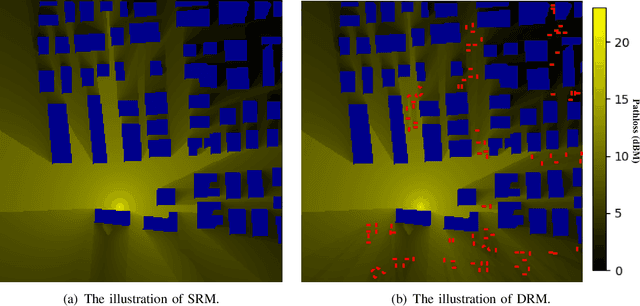

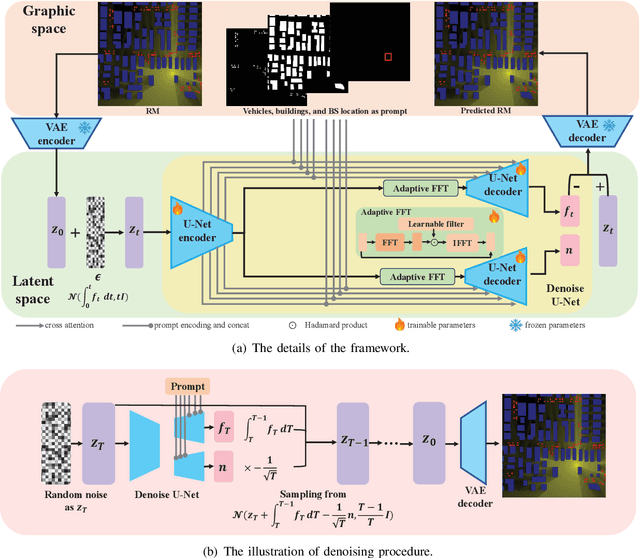
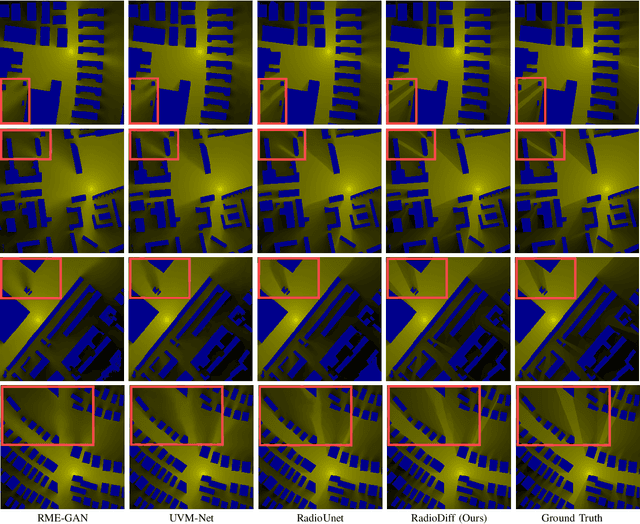
Abstract:Radio map (RM) is a promising technology that can obtain pathloss based on only location, which is significant for 6G network applications to reduce the communication costs for pathloss estimation. However, the construction of RM in traditional is either computationally intensive or depends on costly sampling-based pathloss measurements. Although the neural network (NN)-based method can efficiently construct the RM without sampling, its performance is still suboptimal. This is primarily due to the misalignment between the generative characteristics of the RM construction problem and the discrimination modeling exploited by existing NN-based methods. Thus, to enhance RM construction performance, in this paper, the sampling-free RM construction is modeled as a conditional generative problem, where a denoised diffusion-based method, named RadioDiff, is proposed to achieve high-quality RM construction. In addition, to enhance the diffusion model's capability of extracting features from dynamic environments, an attention U-Net with an adaptive fast Fourier transform module is employed as the backbone network to improve the dynamic environmental features extracting capability. Meanwhile, the decoupled diffusion model is utilized to further enhance the construction performance of RMs. Moreover, a comprehensive theoretical analysis of why the RM construction is a generative problem is provided for the first time, from both perspectives of data features and NN training methods. Experimental results show that the proposed RadioDiff achieves state-of-the-art performance in all three metrics of accuracy, structural similarity, and peak signal-to-noise ratio. The code is available at https://github.com/UNIC-Lab/RadioDiff.
Orbital-Angular-Momentum Embedded Massive MIMO: Achieving Multiplicative Spectrum-Efficiency for mmWave Communications
Aug 13, 2024



Abstract:By enabling very high bandwidth for radio communications, the millimeter-wave (mmWave), which can easily be integrated with massive-multiple-input-multiple-output (massive-MIMO) due to small antenna size, has been attracting growing attention as a candidate for the fifth-generation (5G) and 5G-beyond wireless communications networks. On the other hand, the communication over the orthogonal states/modes of orbital angular momentum (OAM) is a subset of the solutions offered by massive-MIMO communications. Traditional massive-MIMO based mmWave communications did not concern the potential spectrum-efficiency-gain (SE-gain) offered by orthogonal states of OAM. However, the highly expecting maximum SE-gain for OAM and massive-MIMO communications is the product of SE-gains offered by OAM and multiplexing-MIMO. In this paper, we propose the OAM-embedded-MIMO (OEM) communication framework to obtain the multiplicative SE-gain for joint OAM and massive-MIMO based mmWave wireless communications. We design the parabolic antenna for each uniform circular array antenna to converge OAM signals. Then, we develop the mode-decomposition and multiplexing-detection scheme to obtain the transmit signal on each OAM-mode of each transmit antenna. Also, we develop the OEM-water-filling power allocation policy to achieve the maximum multiplicative SE-gain for OEM communications. The extensive simulations obtained validate and evaluate our developed parabolic antenna based converging method, mode-decomposition and multiplexing-detection scheme, and OEM-water-filling policy, showing that our proposed OEM mmWave communications can significantly increase the spectrum-efficiency as compared with traditional massive-MIMO based mmWave communications.
Achieving Practical OAM Based Wireless Communications With Misaligned Transceiver
Aug 13, 2024



Abstract:Orbital angular momentum (OAM) has attracted much attention for radio vortex wireless communications due to the orthogonality among different OAM-modes. To maintain the orthogonality among different OAM modes at the receiver, the strict alignment between transmit and receive antennas is highly demanded. However, it is not practical to guarantee the transceiver alignment in wireless communications. The phase turbulence, resulting from the misaligned transceivers, leads to serious inter-mode interference among different OAM modes and therefore fail for signals detection of multiple OAM modes at the receiver. To achieve practical OAM based wireless communications, in this paper we investigate the radio vortex wireless communications with misaligned transmit and receive antennas. We propose a joint Beamforming and Pre-detection (BePre) scheme, which uses two unitary matrices to convert the channel matrix into the equivalent circulant matrix for keeping the orthogonality among OAM-modes at the receiver. Then, the OAM signals can be detected with the mode-decomposition scheme at the misaligned receiver. Extensive simulations obtained validate and evaluate that our developed joint BePre scheme can efficiently detect the signals of multiple OAM-modes for the misaligned transceiver and can significantly increase the spectrum efficiency.
Movable Frequency Diverse Array for Wireless Communication Security
Jul 26, 2024



Abstract:Frequency diverse array (FDA) is a promising antenna technology to achieve physical layer security by varying the frequency of each antenna at the transmitter. However, when the channels of the legitimate user and eavesdropper are highly correlated, FDA is limited by the frequency constraint and cannot provide satisfactory security performance. In this paper, we propose a novel movable FDA (MFDA) antenna technology where the positions of antennas can be dynamically adjusted in a given finite region. Specifically, we aim to maximize the secrecy capacity by jointly optimizing the antenna beamforming vector, antenna frequency vector and antenna position vector. To solve this non-convex optimization problem with coupled variables, we develop a two-stage alternating optimization (AO) algorithm based on block successive upper-bound minimization (BSUM) method. Moreover, to evaluate the security performance provided by MFDA, we introduce two benchmark schemes, i.e., phased array (PA) and FDA. Simulation results demonstrate that MFDA can significantly enhance security performance compared to PA and FDA. In particular, when the frequency constraint is strict, MFDA can further increase the secrecy capacity by adjusting the positions of antennas instead of the frequencies.
Movable Frequency Diverse Array-Assisted Covert Communication With Multiple Wardens
Jul 26, 2024



Abstract:The frequency diverse array (FDA) is highly promising for improving covert communication performance by adjusting the frequency of each antenna at the transmitter. However, when faced with the cases of multiple wardens and highly correlated channels, FDA is limited by the frequency constraint and cannot provide satisfactory covert performance. In this paper, we propose a novel movable FDA (MFDA) antenna technology where positions of the antennas can be dynamically adjusted in a given finite region. Specifically, we aim to maximize the covert rate by jointly optimizing the antenna beamforming vector, antenna frequency vector and antenna position vector. To solve this non-convex optimization problem with coupled variables, we develop a two-stage alternating optimization (AO) algorithm based on the block successive upper-bound minimization (BSUM) method. Moreover, considering the challenge of obtaining perfect channel state information (CSI) at multiple wardens, we study the case of imperfect CSI. Simulation results demonstrate that MFDA can significantly enhance covert performance compared to the conventional FDA. In particular, when the frequency constraint is strict, MFDA can further increase the covert rate by adjusting the positions of antennas instead of the frequencies.
A Pixel-based Reconfigurable Antenna Design for Fluid Antenna Systems
Jun 08, 2024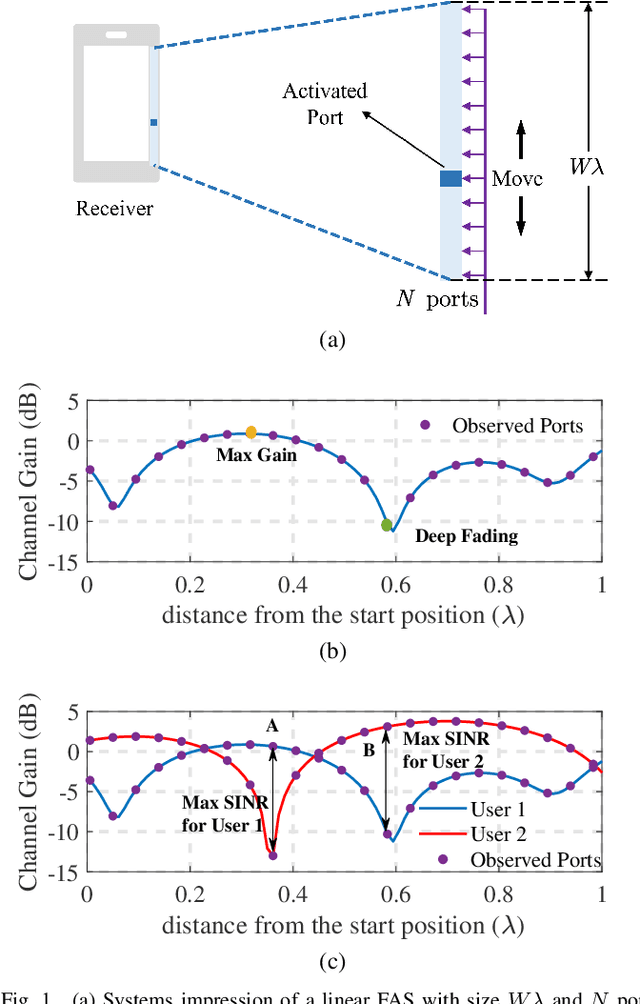
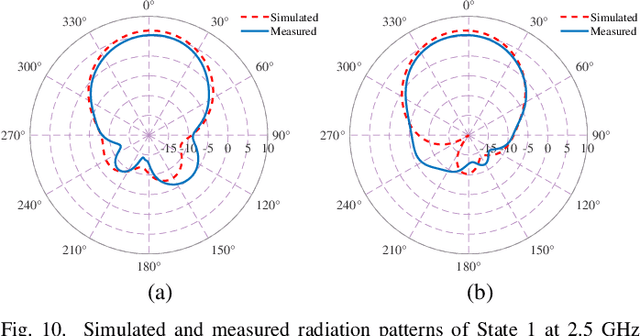
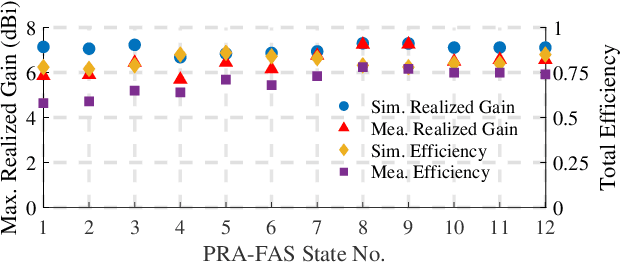
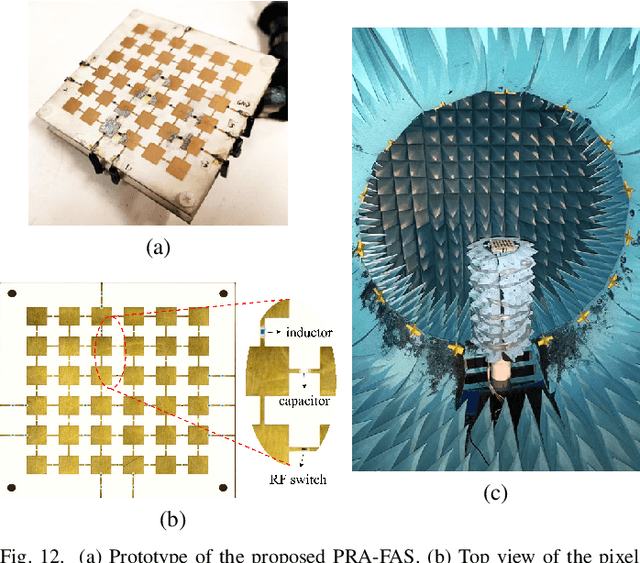
Abstract:Fluid Antenna Systems (FASs) have recently been proposed for enhancing the performance of wireless communication. Previous antenna designs to meet the requirements of FAS have been based on mechanically movable or liquid antennas and therefore have limited reconfiguration speeds. In this paper, we propose a design for a pixel-based reconfigurable antenna (PRA) that meets the requirements of FAS and the required switching speed. It can provide 12 FAS ports across 1/2 wavelength and consists of an E-slot patch antenna and an upper reconfigurable pixel layer with 6 RF switches. Simulation and experimental results from a prototype operating at 2.5 GHz demonstrate that the design can meet the requirements of FAS including port correlation with matched impedance.
 Add to Chrome
Add to Chrome Add to Firefox
Add to Firefox Add to Edge
Add to Edge